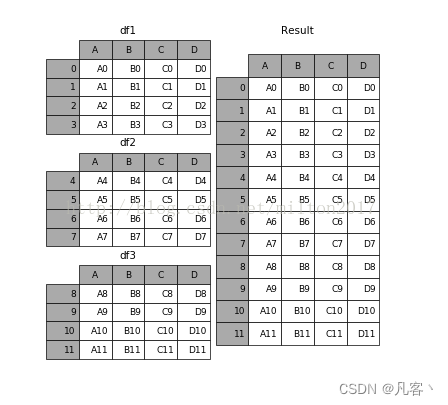pandas用法-详解教程
- 一、生成数据表
- 二、数据表信息查看
- 三、数据表清洗
- 四、数据预处理
- 五、数据提取
- 六、数据筛选
- 七、数据汇总
- 八、数据统计
- 九、数据输出
一、生成数据表
1、首先导入pandas库,一般都会用到numpy库,所以我们先导入备用:
import numpy as np
import pandas as pd
2、导入CSV或者xlsx文件:
df = pd.DataFrame(pd.read_csv('name.csv',header=1))
df = pd.DataFrame(pd.read_excel('name.xlsx'))
或者
import pandas as pd
from collections import namedtupleItem = namedtuple('Item', 'reply pv')
items = []with codecs.open('reply.pv.07', 'r', 'utf-8') as f: for line in f:line_split = line.strip().split('\t')items.append(Item(line_split[0].strip(), line_split[1].strip()))df = pd.DataFrame.from_records(items, columns=['reply', 'pv'])
3、用pandas创建数据表:
df = pd.DataFrame({ "id":[1001,1002,1003,1004,1005,1006], "date":pd.date_range('20130102', periods=6),"city":['Beijing ', 'SH', ' guangzhou ', 'Shenzhen', 'shanghai', 'BEIJING '],"age":[23,44,54,32,34,32],"category":['100-A','100-B','110-A','110-C','210-A','130-F'],"price":[1200,np.nan,2133,5433,np.nan,4432]},columns =['id','date','city','category','age','price'])
二、数据表信息查看
1、维度查看:
df.shape
2、数据表基本信息(维度、列名称、数据格式、所占空间等):
df.info()
3、每一列数据的格式:
df.dtypes
4、某一列格式:
df['B'].dtype
5、空值:
df.isnull()
6、查看某一列空值:
df['B'].isnull()
7、查看某一列的唯一值:
df['B'].unique()
8、查看数据表的值:
df.values
9、查看列名称:
df.columns
10、查看前5行数据、后5行数据:
df.head() #默认前5行数据
df.tail() #默认后5行数据
三、数据表清洗
1、用数字0填充空值:
df.fillna(value=0)
2、使用列prince的均值对NA进行填充:
df['prince'].fillna(df['prince'].mean())
3、清楚city字段的字符空格:
df['city']=df['city'].map(str.strip)
4、大小写转换:
df['city']=df['city'].str.lower()
5、更改数据格式:
df['price'].astype('int')
6、更改列名称:
df.rename(columns={ 'category': 'category-size'})
7、删除后出现的重复值:
df['city'].drop_duplicates()
8 、删除先出现的重复值:
df['city'].drop_duplicates(keep='last')
9、数据替换:
df['city'].replace('sh', 'shanghai')
四、数据预处理
df1=pd.DataFrame({ "id":[1001,1002,1003,1004,1005,1006,1007,1008],
"gender":['male','female','male','female','male','female','male','female'],
"pay":['Y','N','Y','Y','N','Y','N','Y',],
"m-point":[10,12,20,40,40,40,30,20]})
1、数据表合并
1.1 merge
df_inner=pd.merge(df,df1,how='inner') # 匹配合并,交集
df_left=pd.merge(df,df1,how='left') #
df_right=pd.merge(df,df1,how='right')
df_outer=pd.merge(df,df1,how='outer') #并集
1.2 append
result = df1.append(df2)

1.3 join
result = left.join(right, on='key')

1.4 concat
pd.concat(objs, axis=0, join='outer', join_axes=None, ignore_index=False,keys=None, levels=None, names=None, verify_integrity=False,copy=True)
- objs︰ 一个序列或系列、 综合或面板对象的映射。如果字典中传递,将作为键参数,使用排序的键,除非它传递,在这种情况下的值将会选择(见下文)。任何没有任何反对将默默地被丢弃,除非他们都没有在这种情况下将引发 ValueError。
- axis: {0,1,…},默认值为 0。要连接沿轴。
- join: {‘内部’、 ‘外’},默认 ‘外’。如何处理其他 axis(es) 上的索引。联盟内、 外的交叉口。
- ignore_index︰ 布尔值、 默认 False。如果为 True,则不要串联轴上使用的索引值。由此产生的轴将标记
0,…,n-1。这是有用的如果你串联串联轴没有有意义的索引信息的对象。请注意在联接中仍然受到尊重的其他轴上的索引值。 - join_axes︰ 索引对象的列表。具体的指标,用于其他 n-1 轴而不是执行内部/外部设置逻辑。 keys︰
序列,默认为无。构建分层索引使用通过的键作为最外面的级别。如果多个级别获得通过,应包含元组。 - levels︰ 列表的序列,默认为无。具体水平 (唯一值) 用于构建多重。否则,他们将推断钥匙。
- names︰ 列表中,默认为无。由此产生的分层索引中的级的名称。
- verify_integrity︰ 布尔值、 默认 False。检查是否新的串联的轴包含重复项。这可以是相对于实际数据串联非常昂贵。
副本︰ 布尔值、 默认 True。如果为 False,请不要,不必要地复制数据。
例子:1.frames = [df1, df2, df3]2.result = pd.concat(frames)

2、设置索引列
df_inner.set_index('id')
3、按照特定列的值排序:
df_inner.sort_values(by=['age'])
4、按照索引列排序:
df_inner.sort_index()
5、如果prince列的值>3000,group列显示high,否则显示low:
df_inner['group'] = np.where(df_inner['price'] > 3000,'high','low')
6、对复合多个条件的数据进行分组标记
df_inner.loc[(df_inner['city'] == 'beijing') & (df_inner['price'] >= 4000), 'sign']=1
7、对category字段的值依次进行分列,并创建数据表,索引值为df_inner的索引列,列名称为category和size
pd.DataFrame((x.split('-') for x in df_inner['category']),index=df_inner.index,columns=['category','size']))
8、将完成分裂后的数据表和原df_inner数据表进行匹配
df_inner=pd.merge(df_inner,split,right_index=True, left_index=True)
五、数据提取
主要用到的三个函数:loc,iloc和ix,loc函数按标签值进行提取,iloc按位置进行提取,ix可以同时按标签和位置进行提取。
1、按索引提取单行的数值
df_inner.loc[3]
2、按索引提取区域行数值
df_inner.iloc[0:5]
3、重设索引
df_inner.reset_index()
4、设置日期为索引
df_inner=df_inner.set_index('date')
5、提取4日之前的所有数据
df_inner[:'2013-01-04']
6、使用iloc按位置区域提取数据
df_inner.iloc[:3,:2] #冒号前后的数字不再是索引的标签名称,而是数据所在的位置,从0开始,前三行,前两列。
7、适应iloc按位置单独提起数据
df_inner.iloc[[0,2,5],[4,5]] #提取第0、2、5行,4、5列
8、使用ix按索引标签和位置混合提取数据
df_inner.ix[:'2013-01-03',:4] #2013-01-03号之前,前四列数据
9、判断city列的值是否为北京
df_inner['city'].isin(['beijing'])
10、判断city列里是否包含beijing和shanghai,然后将符合条件的数据提取出来
df_inner.loc[df_inner['city'].isin(['beijing','shanghai'])]
11、提取前三个字符,并生成数据表
pd.DataFrame(category.str[:3])
六、数据筛选
使用与、或、非三个条件配合大于、小于、等于对数据进行筛选,并进行计数和求和。
1、使用“与”进行筛选
df_inner.loc[(df_inner['age'] > 25) & (df_inner['city'] == 'beijing'), ['id','city','age','category','gender']]
2、使用“或”进行筛选
df_inner.loc[(df_inner['age'] > 25) | (df_inner['city'] == 'beijing'), ['id','city','age','category','gender']].sort(['age'])
3、使用“非”条件进行筛选
df_inner.loc[(df_inner['city'] != 'beijing'), ['id','city','age','category','gender']].sort(['id'])
4、对筛选后的数据按city列进行计数
df_inner.loc[(df_inner['city'] != 'beijing'), ['id','city','age','category','gender']].sort(['id']).city.count()
5、使用query函数进行筛选
df_inner.query('city == ["beijing", "shanghai"]')
6、对筛选后的结果按prince进行求和
df_inner.query('city == ["beijing", "shanghai"]').price.sum()
七、数据汇总
主要函数是groupby和pivote_table
1、对所有的列进行计数汇总
df_inner.groupby('city').count()
2、按城市对id字段进行计数
df_inner.groupby('city')['id'].count()
3、对两个字段进行汇总计数
df_inner.groupby(['city','size'])['id'].count()
4、对city字段进行汇总,并分别计算prince的合计和均值
df_inner.groupby('city')['price'].agg([len,np.sum, np.mean])
八、数据统计
数据采样,计算标准差,协方差和相关系数
1、简单的数据采样
df_inner.sample(n=3)
2、手动设置采样权重
weights = [0, 0, 0, 0, 0.5, 0.5]
df_inner.sample(n=2, weights=weights)
3、采样后不放回
df_inner.sample(n=6, replace=False)
4、采样后放回
df_inner.sample(n=6, replace=True)
5、 数据表描述性统计
df_inner.describe().round(2).T #round函数设置显示小数位,T表示转置
6、计算列的标准差
df_inner['price'].std()
7、计算两个字段间的协方差
df_inner['price'].cov(df_inner['m-point'])
8、数据表中所有字段间的协方差
df_inner.cov()
9、两个字段的相关性分析
df_inner['price'].corr(df_inner['m-point']) #相关系数在-1到1之间,接近1为正相关,接近-1为负相关,0为不相关
10、数据表的相关性分析
df_inner.corr()
九、数据输出
分析后的数据可以输出为xlsx格式和csv格式
1、写入Excel
df_inner.to_excel('excel_to_python.xlsx', sheet_name='bluewhale_cc')
2、写入到CSV
df_inner.to_csv('excel_to_python.csv')
vite.config.ts的配置与axios安装)





)





)



:复制、删除、锁定、层叠顺序)


